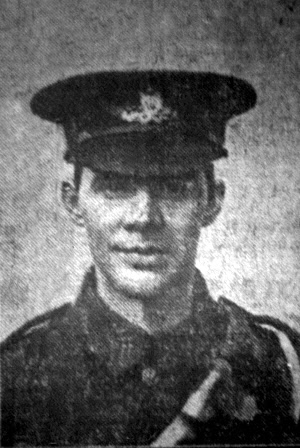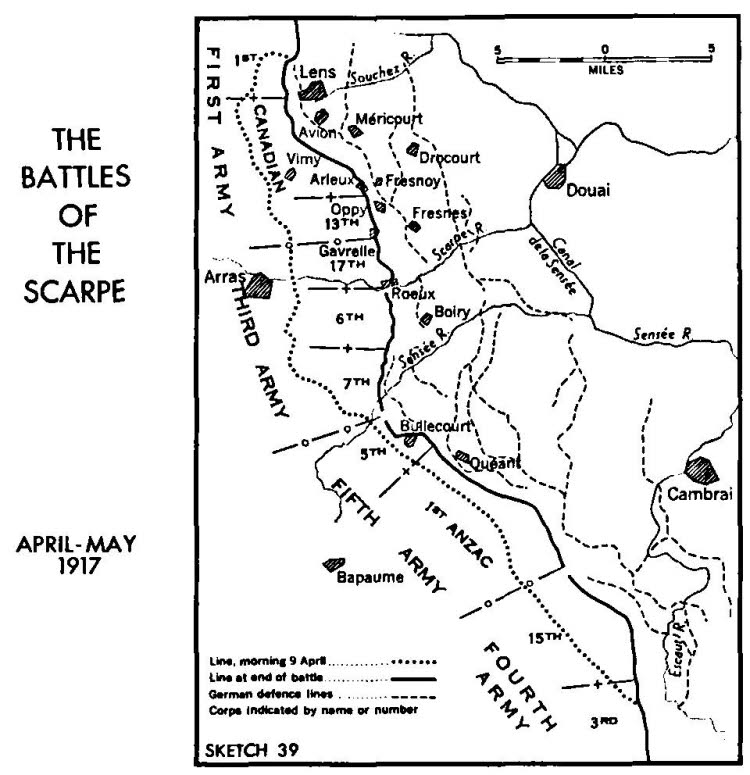
Herbert Gordon Gee was born in early 1887 in Marsden, Huddersfield, the son of Scammonden born Edward Gee and Mary Eliza (nee Shaw, born Stainland, Halifax) who had married in the Halifax registration district in 1877. Herbert was baptised on the 6th April 1890 in Stainland, Halifax.
In 1891 Edward and Mary E. Gee are living at Station Road, Liversedge with their three sons John W. (born 1879), Joseph Alfred (born 1884) and Herbert G. (born 1887). By 1901, the family have moved to 124 High Street, Morley, Leeds where Edward is working as a crane driver in a stone quarry. The Gees now have four children, all boys, the latest addition being Norman E. born in 1895. Herbert is now aged 14 and working as a mule piecer in a woollen mill. His elder brothers are both working as scrappers and labourers in a stone quarry.
In 1911 the family have moved to Ossett and Edward, now working as a power loom tuner and his wife Mary Eliza Gee are living at 7, Moorcroft Street with their two youngest sons, Herbert, a cloth picker, and Norman, aged 15, an assistant power loom tuner. The Census records that Edward and Mary Eliza have been married for 33 years and they have had 6 children, two having died before 1911.
Herbert Gee married Frances Charlesworth, in the Glanford Brigg registration district of north Lincolnshire in 1915. They had a daughter, Ruth Gee, who was born in 1916 in Huddersfield. Gunner, 152564, Herbert G. Gee’s service record has not survived, but his Medal Card shows that he was awarded the Victory and British medals indicating that he did not serve abroad before the 31st December 1915, although he may have enlisted at an earlier date.
Gunner Herbert Gordon Gee died on the 24th April 1917, aged 30, the husband of Frances Gee, of 11, Woodbine St., Ossett, Yorks. Herbert served with “D” Battery, (78th) LXXVIII Brigade, Royal Field Artillery, part of the 17th (Northern) Division.
The “Ossett Observer” 1 had this report of Gunner Gee’s death:
“Local men who have fallen in recent operations include Gunner Herbert Gordon Gee (30) of the Royal Field Artillery, a married man of Woodbine-street, Ossett and brother of Police-sergeant Gee, of Middlestown. Deceased, who hailed from Marsden had lived in Ossett for some time before he took up military duties in August last, and was one of the steeple ringers at Holy Trinity Parish Church. He used to work at Ings Mill, Dale Street.
In a letter, which his section officer has forwarded to Police-sergeant Gee, conveying the sympathy of himself and his comrades, the writer comments that Gunner Gee was a brave and good soldier. He adds: He was killed whilst doing his duty and upholding the highest traditions of the Royal Regiment of Artillery. His resting place is a pretty one, just outside a village that is now a heap of ruins. It is a piece of ground that is now English property, and will be kept in order for all time. Near our horse lines some primroses are growing, reminding us of home. I placed some roots on his grave and enclose a few of the flowers, knowing that you will value them. May you in grief know that Gunner Gee died in the service of his God, his king and his country.”
The 78th Brigade of the RFA was equipped with 18 pounder guns, hauled into action by a team of six horses. Each pair of horses would have a driver. The Brigade would have three batteries of six guns each.
17th (Northern) Division was formed in September 1914, as part of Kitchener’s Second New Army. After initial training close to home, the Division moved to Dorset to continue training and then, in late May 1915, moved to the Winchester area. The division had been selected for Home Defence duties, but this was reversed and they proceeded to France in July 1915, concentrating near St Omer. They moved into the Southern Ypres salient for trench familiarisation and then took over the the front lines in that area. In the spring of 1916 they were in action at the Bluff, south east of Ypres on the Comines canal then moved south to The Somme seeing action during The Battle of Albert in which the Division captured Fricourt and The Battle of Delville Wood. In 1917 they moved to Arras and saw action in The First and Second Battles of the Scarpe. It was in the Second Battle of the Scarpe, which commenced on St. George’s Day, Monday the 23rd of April 1917 that Gunner Gee was killed in action.

Above: Royal Field Artillery gun crew with an 18lb gun at Arras in 1917. Herbert Gee would have been in a crew like this at the 2nd Battle of the Scarpe.
“The 17th Division received warning orders to begin immediate preparation for taking part in the general advance of the whole line on the Arras front, at dawn on Friday, 20th April. But on the 19th, there was a change of plans and the advance was deferred to St. George’s Day, Monday, April the 23rd.
On the front held by the 17th Division the first objective was to be the clearing of the enemy positions that formed a salient of his line on the south bank of the Scarpe opposite Roeux and north of Monchy-le-Preux. The orders contemplated a further advance to Pelves village if this ground was won. In preparation for the attack, the 51st Brigade had been brought up to the front line, and the two battalions that were to lead the assault, the 7th Borders on the right and the 8th South Staffords on the left, were in the assembly trenches dug on a line running north and south through Lone Copse. The 9th Northumberland Fusiliers (52nd Brigade) were attached to the 51st and posted so as to cover the right of the attack and connect up with the 29th Division north-east of Monchy. Two tanks were at the disposal of the G.O.C. 51st Brigade, but unfortunately both broke down on their way to the assembly position. Trench mortars were placed at the south end of Bayonet Trench to enfilade it and fire also on Rifle Trench. Bayonet Trench followed the crest of a line of a spur running from the direction of Monchy towards the Scarpe, and Rifle Trench joined it at right-angles about half-way along its length. On the left, near the Scarpe, other mortars were placed to put down a smoke barrage on the line of the river covering the left flank, and doing something to shelter the advance from fire from the north bank. The 50th Brigade was in support, and the 52nd (less the Northumberland Fusiliers) was in reserve at the Railway Triangle.
Covered by a barrage, the assaulting battalions left the assembly trenches at zero hours, 4:45 a.m. on St. George’s Day. Hardly had they gone over the top when the enemy’s barrage came down, and at the same time a well-sustained bombardment opened up upon Monchy and the ground on its neighbourhood, and a tremendous enfilade fire of machine guns came from the north side of the Scarpe. By unlucky mistake, the wire in front of the German line was hardly anywhere cut. Twice the Staffords, on the left, attacked the north end of Bayonet Trench, but both attacks were repulsed with serious loss. On the right the Borders fought their way into and along the south end of the trench nearly up to its junction with Rifle Trench. They also made a push for the latter trench across the cratered ground in the angle between it and the front line. This attack did not reach it, but parties of Borders held on in shell holes until they were withdrawn after dark that evening.
The two other battalions of the 51st Brigade – 7th Lincolns and 10th Sherwoods – had meanwhile been brought into the Lone Copse assembly trenches from the old front line. The G.O.C. 51st Brigade ordered the Lincolns to attack the north end of Bayonet Trench, after the remnants of the Staffords had been withdrawn to Lone Copse, and sent a request through for a barrage to cover their advance. By some mischance a message from the Divisional HQ countermanding the attack as the artillery was not just then able to help, came through to late, just after the Lincolns had moved forward at 8 a.m. They reached the enemy’s wire with a rush, but there the attack was held. Under a cross fire from the trench in front and machine gun bullets from the other side of the Scarpe, officers and men lay down trying to work under or cut through the barrier of intact wire. The attack failed with losses amounting to 200 of all ranks. On the same ground the Staffords had already lost 215 officers and men.

After this there was for some hours a lull in the battle until early in the afternoon the 50th Brigade was moved up from the support position with orders to pass through the 51st Brigade and renew the attack on Bayonet and Rifle trenches, and if this succeeded endeavour to make further progress eastwards. The Brigade came under heavy artillery fire during this movement. When at 3:30 p.m. the leading battalions attacked Bayonet Trench it was believed that Roeux was in the hands of the Division next to the northward on the further bank of the Scarpe, and that the left flank was therefore secure. But Rouex had been retaken by the enemy, and the advance of the 50th Brigade was held and repulsed by cross fire from the Trench and from machine guns in Roeux. After the failure of this attack no further advance was attempted that day and all efforts were devoted to consolidating the position.
Although on both banks of the Scarpe the day had been disappointing, at many other points on the line of eight miles covered by the attack on St. George’s Day a fair amount of ground had been won, despite the obstinate resistance everywhere made by the enemy, who had seven divisions in action. At this stage of the Arras battle the chief object of the operations was to occupy as many German Divisions as possible, and so lighten the task of the French. This was all the more important because Nivelle’s offensive was faring badly. His advance was everywhere held at enormous cost.” 2
Gunner Herbert Gee is buried at the Tilloy British Cemetery 3, Tilloy-Les-Mofflaines, Pas-de-Calais, France at grave reference I. B. 18. Tilloy-les-Mofflaines is a village 3 kilometres south-east of Arras, on the south side of the main road to Cambrai. Tilloy British Cemetery is south-east of the village on the north-east side of the road to Wancourt, the D37.
The cemetery was begun in April 1917 by fighting units and burial officers, and Rows A to H in Plot I largely represent burials from the battlefield. The remaining graves in Plot I, and others in the first three rows of Plot II, represent later fighting in 1917 and the first three months of 1918, and the clearing of the village in August 1918. These 390 original burials were increased after the Armistice when graves were brought in from a wide area east of Arras and from smaller burial grounds nearby.
The cemetery now contains 1,642 Commonwealth burials and commemorations of the First World War. 611 of the burials are unidentified, but there are special memorials to 14 casualties known or believed to be buried among them. Other special memorials commemorate 11 men of the 6th Bn. K.O.S.B., buried in Tees Trench Cemetery No.2, whose graves were destroyed by shell fire.
References:
1. “Ossett Observer”, 5th May 1917
2. “The History of the 17th (Northern) Division”, by A Hilliard Atteridge, Publisher: Robert Maclehose & Co. Ltd. 1929,